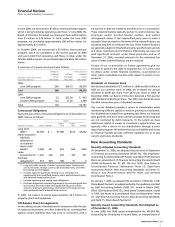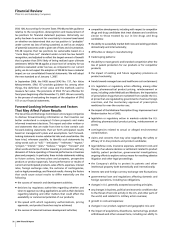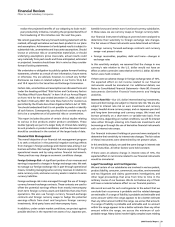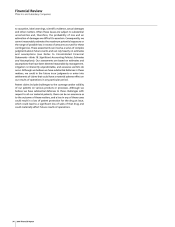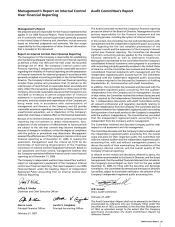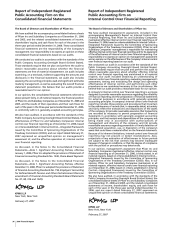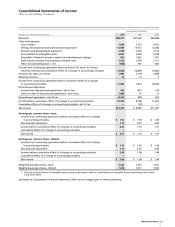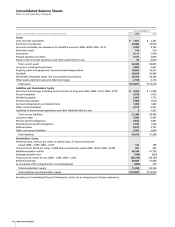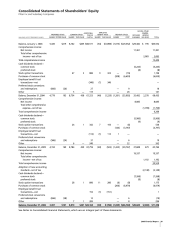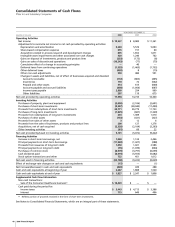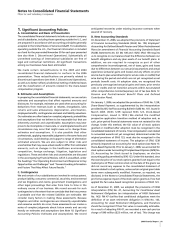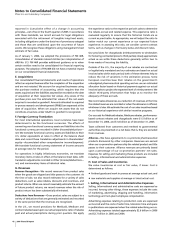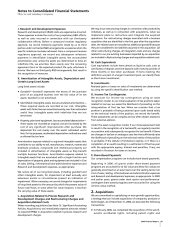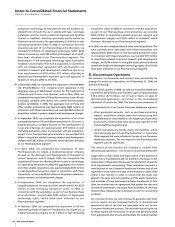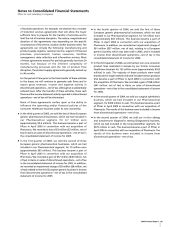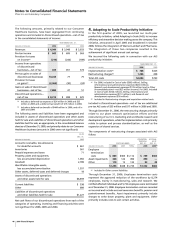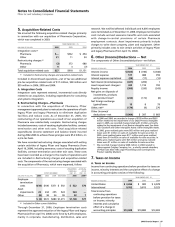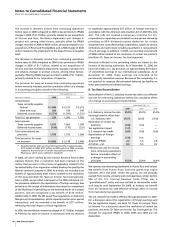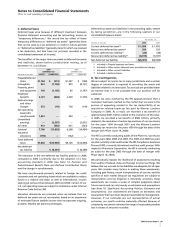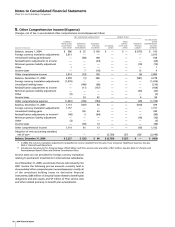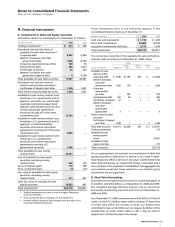Pfizer 2006 Annual Report Download - page 43
Download and view the complete annual report
Please find page 43 of the 2006 Pfizer annual report below. You can navigate through the pages in the report by either clicking on the pages listed below, or by using the keyword search tool below to find specific information within the annual report.
2006 Financial Report 41
Notes to Consolidated Financial Statements
Pfizer Inc and Subsidiary Companies
1.
Significant Accounting Policies
A. Consolidation and Basis of Presentation
The consolidated financial statements include our parent company
and all subsidiaries, including those operating outside the U.S., and
are prepared in accordance with accounting principles generally
accepted in the United States of America (GAAP). For subsidiaries
operating outside the U.S., the financial information is included
as of and for the year ended November 30 for each year presented
(see also Note 3. Discontinued Operations). Substantially all
unremitted earnings of international subsidiaries are free of
legal and contractual restrictions. All significant transactions
among our businesses have been eliminated.
We made certain reclassifications to the 2005 and 2004
consolidated financial statements to conform to the 2006
presentation. These reclassifications are primarily related to
discontinued operations (see Note 3. Discontinued Operations),
as well as to better reflect jurisdictional netting of deferred taxes
and the classification of amounts related to the share-based
compensation program.
B. Estimates and Assumptions
In preparing the consolidated financial statements, we use certain
estimates and assumptions that affect reported amounts and
disclosures. For example, estimates are used when accounting for
deductions from revenues (such as rebates, chargebacks, sales
returns and sales allowances), depreciation, amortization,
employee benefits, contingencies and asset and liability valuations.
Our estimates are often based on complex judgments, probabilities
and assumptions that we believe to be reasonable but that are
inherently uncertain and unpredictable. Assumptions may later
prove to be incomplete or inaccurate, or unanticipated events and
circumstances may occur that might cause us to change those
estimates and assumptions. It is also possible that other
professionals, applying reasonable judgment to the same facts and
circumstances, could develop and support a range of alternative
estimated amounts. We are also subject to other risks and
uncertainties that may cause actual results to differ from estimated
amounts, such as changes in the healthcare environment,
competition, foreign exchange, litigation, legislation and
regulations. These and other risks and uncertainties are discussed
in the accompanying Financial Review, which is unaudited, under
the headings “Our Operating Environment and Response to Key
Opportunities and Challenges” and “Forward-Looking Information
and Factors That May Affect Future Results.”
C. Contingencies
We and certain of our subsidiaries are involved in various patent,
product liability, consumer, commercial, securities, environmental
and tax litigations and claims; government investigations; and
other legal proceedings that arise from time to time in the
ordinary course of our business. We record accruals for such
contingencies to the extent that we conclude that their occurrence
is probable and that the related liabilities are estimable. We
consider many factors in making these assessments. Because
litigation and other contingencies are inherently unpredictable
and excessive verdicts do occur, these assessments can involve a
series of complex judgments about future events and can rely
heavily on estimates and assumptions (see Note 1B. Significant
Accounting Policies: Estimates and Assumptions). We record
anticipated recoveries under existing insurance contracts when
assured of recovery.
D. New Accounting Standards
On December 31, 2006, we adopted the provisions of Statement
of Financial Accounting Standards (SFAS) No. 158, Employers’
Accounting for Defined Benefit Pension and Other Postretirement
Plans (an amendment of Financial Accounting Standards Board
(FASB) Statements No. 87, 88, 106 and 132R). SFAS 158 requires
us to recognize on our balance sheet the difference between our
benefit obligations and any plan assets of our benefit plans. In
addition, we are required to recognize as part of other
comprehensive income/(expense), net of taxes, gains and losses
due to differences between our actuarial assumptions and actual
experience (actuarial gains and losses) and any effects on prior
service due to plan amendments (prior service costs or credits) that
arise during the period and which are not yet recognized as net
periodic benefit costs. At adoption date, we recognized the
previously unrecognized actuarial gains and losses, prior service
costs or credits and net transition amounts within Accumulated
other comprehensive income/(expense), net of tax (see Note 13.
Pension and Postretirement Benefit Plans and Defined
Contribution Plans).
On January 1, 2006, we adopted the provisions of SFAS No. 123R,
Share-Based Payment, as supplemented by the interpretation
provided by SEC Staff Accounting Bulletin (SAB) No. 107, issued in
March 2005. (SFAS 123R replaced SFAS 123, Stock-Based
Compensation, issued in 1995.) We elected the modified
prospective application transition method of adoption and, as
such, prior-period financial statements were not restated for this
change. Under this method, the fair value of all stock options
granted or modified after adoption must be recognized in the
consolidated statement of income. Total compensation cost related
to nonvested awards not yet recognized, determined under the
original provisions of SFAS 123, must also be recognized in the
consolidated statement of income. The adoption of SFAS 123R
primarily impacted our accounting for stock options (see Note 15.
Share-Based Payments). Prior to January 1, 2006, we accounted for
stock options under Accounting Principles Board Opinion (APB) No.
25, Accounting for Stock Issued to Employees, an elective
accounting policy permitted by SFAS 123. Under this standard, since
the exercise price of our stock options granted is set equal to the
market price of Pfizer common stock on the date of the grant, we
did not record any expense to the consolidated statement of
income related to stock options, unless certain original grant date
terms were subsequently modified. However, as required, we
disclosed, in the Notes to Consolidated Financial Statements, the
pro forma expense impact of the stock option grants as if we had
applied the fair-value-based recognition provisions of SFAS 123.
As of December 31, 2005, we adopted the provisions of FASB
Interpretation (FIN) No. 47, Accounting for Conditional Asset
Retirement Obligations (an interpretation of FASB Statement
No. 143). FIN 47 clarifies that conditional obligations meet the
definition of an asset retirement obligation in SFAS No. 143,
Accounting for Asset Retirement Obligations, and therefore
should be recognized if their fair value is reasonably estimable.
As a result of adopting FIN 47, we recorded a non-cash pre-tax
charge of $40 million ($23 million, net of tax). This charge was


